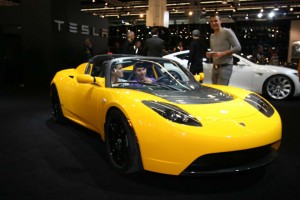
The Tesla Roadster 2.0 is getting an upgrade to 3.0 to extend the car's range from 245 miles to 400 miles.
Tesla’s founder, Elon Musk, has been making noise on Twitter about an announcement regarding the company’s first vehicle – the Roadster – for more than a week and now he’s let the cat out of the bag: it can go nearly 400 miles on a charge.
The improved results are coming from a new prototype package the company calls Roadster 3.0. Those changes include an improved lithium ion battery that has 31% more energy, a retro-fitted aero kit to improve the vehicle’s coefficient of drag and low-resistance tires that are 20% better than their predecessors. Tesla officials declined to elaborate on pricing or availability. The Roadster originally had a range of about 245 miles on a charge.
“Combining all of these improvements we can achieve a predicted 40-50% improvement on range between the original Roadster and Roadster 3.0,” the company wrote in a blog post. “There is a set of speeds and driving conditions where we can confidently drive the Roadster 3.0 over 400 miles.
“We will be demonstrating this in the real world during a non-stop drive from San Francisco to Los Angeles in the early weeks of 2015. We are confident that this will not be the last update the Roadster will receive in the many years to come.”
The company ceased production on the Roadster in 2012 so resources could be devoted to the Model S as well as development on the Model X, which is set to debut sometime in 2015. It sold 2,150 of the two-seat Roadsters from 2008, when it was introduced, through the end of 2011, according to the company.
The news comes just a week after the company said it would begin piloting the battery swap technology is showcased earlier this year. The technology allows Model S owners in need of a battery charge the choice of either fast or free, the company said.
(Tesla stock price sliding due to low gas prices. For more, Click Here.)
The swap will be done by appointment only at a facility in Harris Ranch, California. While using the company’s network of supercharges is free, the battery swap will cost a little more than a full tank of premium gas.
It’ll take about three minutes to make the exchanges, which includes removing the titanium and hardened aluminum ballistic plates that now shield the battery pack.
(Click Here for details about the departure of Tesla’s China chief.)
“With further automation and refinements on the vehicle side, we are confident that the swap time could be reduced to less than one minute, even with shields,” the company notes.
(To see more about why half of all EVs are sold in California, Click Here.)
The EV maker will evaluate relative demand from customers for paid pack swap versus free charging to assess whether it merits the engineering resources and investment necessary for that upgrade.

It would be fun to see what these EV’s get for travel distance under real world conditions like cold, snow, etc. not just sunny CA or FL.
About the “X”, it was started in 2010. Now it won’t be out until the end of 2015. 5 years to develop a vehicle is not very “game changing”. Neither are door designs taken from the delorean.